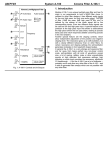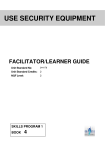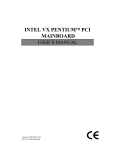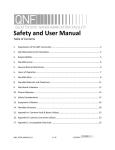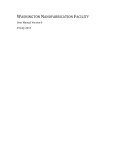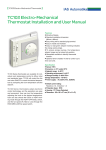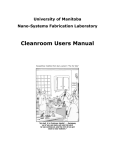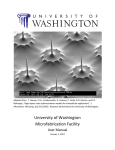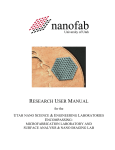Download You - Department of Computer Science & Engineering
Transcript
NRF Cleanroom Safety Manual Nano Research Facility: Laboratory Manager: Nathan Reed Office: EPSc L27A Tel: 314-935-7640 Email: [email protected] A. GENERAL INFORMATION 1. Basic rules and procedures. (a) Training and access All users must first complete the annual safety training offered through the EH&S department. A copy must be placed in the lab Blue Book. All users must complete laboratory specific training prior to gaining independent access to the lab and sign the training record in the lab Blue Book. Each user will be given card access to the cleanroom after completing cleanroom training. (b) Gowning and Personal Storage Each user will wear disposable shoe covers and a hair net before entering the gowning area. Each user receives a hood, a garment, and a pair of cleanroom boots to be worn in the class 1,000 and class 100 bays. Users may store personal items in one of the lockers outside of the gowning area. (c) Specific policies Any “NEW” chemicals stored in the lab, must first be approved by Staff. Confirm there is a MSDS for the chemical(s) you wish to bring in. You are responsible for providing an MSDS if there is not a copy in the MSDS notebook. Do not bring Kleenex, card board, or any particle producing products into the cleanroom. Cleanroom paper and notebook are preferred for taking notes in the cleanroom. All approved items that are brought into the cleanroom must be wiped down to remove dust particles and oil. Manipulation (transferring containers, pipetting, etc…) of nanomaterials, even those suspended in liquid, should take place in a fume hood whenever possible. o ALL manipulation of dry, loose, nanomaterials MUST take place in a properly operated fume hood. 1 B. CHEMICAL SAFETY POLICIES 1. Basic rules and procedures (a) Accidents and spills for chemicals Not containing Nano-Materials Spills of non-hazardous materials may be cleaned with damp cleanroom wipes or a spill kit. If a spill of hazardous and/or volatile materials occurs outside of a fume hood (i.e. the chmical and/or fumes are uncontained), all lab personnel must leave the lab immediately. Do not attempt to clean up a spill of volatile hazardous waste or a large hazardous waste spill yourself; you could be exposing yourself to great danger! Spills: Call University Police at 935-5555 and give them your location (building name and room number), your name, the number of the nearest safe phone to call back on and the nature of the spill---chemical, biological, or radiological. Notify the lab manager, Nathan Reed at 5-7640 or 5-7264. Eye Contact: Promptly flush eyes with water for a minimum period (15 minutes) and seek medical attention. Ingestion: Encourage the victim to drink large amounts of water and seek medical attention. Skin Contact: Promptly flush the affected area with water (15 minutes) and remove any contaminated clothing. Seek medical attention. All injuries or illnesses shall be reported to the Insurance Department (935-5547) for medical treatment authorization, and Environmental Health and Safety (362-6816) for analysis and recommendations for future prevention of the incident. Complete the Report of Injury or Illness form available at the Insurance Department website at http://www.insurance.wustl.edu or in the Blue Book. (b) Accidents and spills for chemicals Containing Nano-Materials In a fume hood small spills of nano-materials in a liquid may be cleaned with cleanroom wipes and/or a spill kit. All materials contaminated with nano-materials should be collected and sealed in a plastic bag while still in the fume hood. Notify lab personnel for proper disposal, noting the type of nano-material, type of liquid and any equipment that may have been contaminated. In a fume hood small spills of dry nano-materials may be cleaned with WET cleanroom wipes. All materials contaminated with nano-materials should be collected and sealed in a plastic bag while still in the fume hood. Notify lab personnel for proper disposal, noting the type of nano-material and any equipment that may have been contaminated. If a spill occurs outside a fume hood all lab users should contact lab personnel and leave 2 the lab. Do not attempt to clean up a spill of nano-materials outside of a fume hood yourself; you could be exposing yourself to great danger! (c) (d) In the event that your lab coat or clothing is contaminated with nanomaterials remove the contaminated clothing and place in a large plastic bag. Eye Contact: Promptly flush eyes with water for a minimum period (15 minutes) and seek medical attention. Ingestion: Encourage the victim to drink large amounts of water and seek medical attention. Skin Contact: Promptly flush the affected area with water (15 minutes) and remove any contaminated clothing. Seek medical attention. All injuries or illnesses shall be reported to the Insurance Department (935-5547) for medical treatment authorization, and Environmental Health and Safety (362-6816) for analysis and recommendations for future prevention of the incident. Complete the Report of Injury or Illness form available at the Insurance Department website at http://www.insurance.wustl.edu or in the Blue Book. Avoidance of "routine" exposure: Develop and practice safe habits that avoid unnecessary exposure to chemicals by any route: Do not smell or taste chemicals. Vent apparatus that may discharge toxic chemicals (vacuum pumps, distillation columns, etc.) into local exhaust devices. Use a fume hood whenever possible. Choice of chemicals: Use only those chemicals for which the quality of the available ventilation system is appropriate. Know about the chemicals you work with by reading MSDS for detailed information. A MSDS (Material Safety Data Sheet) is to be supplied by the user. The MSDS binder is located in the cabinet with the Blue Book. All chemicals and samples brought into the lab must be clearly labeled with user name, group (supervisor) name, contact information (email or phone number), chemical name, and the date. Full information is not required on each sample; you may label your sample rack with full information and samples with abbreviated information (minimum of chemical formula and initials). No open containers of liquids are permitted in the storage cabinets or fume hoods. Collect all hazardous waste in the appropriate waste containers located in the solvent and acid fume hoods. Do not mix different waste types. 3 Make sure you DO NOT use the solvent hood for acid operations, and vice versa. Clean up any countertop spills immediately. Dispose of contaminated labware and consumable supplies in appropriately labeled waste containers. Dispose of sharps (glass slides, silicon wafers, needles, blades, etc…) in labeled sharps containers only. Select chemical carcinogens shall only be used in the designated areas. In this laboratory, the designated areas are the chemical fume hoods. (e) Eating, drinking, smoking, etc: Eating, drinking, smoking, handling contact lenses and applying cosmetics is strictly prohibited in areas where hazardous laboratory chemical or biological materials are used or are intended for use. Storage of food and beverage in containers or in areas that are intended or are used for storage of hazardous laboratory materials is prohibited. (f) Equipment and glassware: Handle and store laboratory glassware with care to avoid damage. Inspect glassware before each use and do not use damaged glassware. Use extra care with Dewar flasks and other evacuated glass apparatus. Shield or wrap them to contain chemicals and fragments should implosion occur. Use equipment only for its designed purpose (See Equipment Policies below). (g) Exiting: Remove gloves and/or wash areas of exposed skin well before exiting the laboratory. Do NOT touch the door handle if you are wearing gloves! (h) Horseplay: Avoid practical jokes or other behavior that might confuse, startle or distract another worker. (i) Mouth pipeting: Do not use mouth for pipeting or starting a siphon. (j) Personal apparel: Confine long hair and loose clothing. See Dress Code. (k) Personal housekeeping: Keep the work area clean and uncluttered, with chemicals and equipment properly labeled and stored. Clean up the work area on completion of an operation or at the end of each day. (m) Personal protection: Assure that all persons, including visitors, wear appropriate eye protection where chemicals and biological agents are stored or handled. Wear appropriate gloves when the potential for contact with toxic materials exists. Inspect the gloves before each use and replace them periodically or when damaged. If handling nanomaterials in the hood dispose of gloves in trash receptacle INSIDE the 4 fume hood. Nitrile gloves (large, medium & small) are available in the lab. Use appropriate respiratory equipment when air contaminant concentrations are not sufficiently restricted by engineering controls. The Environmental Health and Safety Office will determine if respiratory protection is required. Use any other protective and emergency apparel and equipment as appropriate. Remove laboratory coat or cleanroom gown immediately upon significant contamination and place in bin for washing. (n) Planning: Seek information and advice about hazards before starting an experiment. Plan appropriate protective procedures, and positioning of equipment before beginning any new operation. (o) Unattended operations: Leave lights on, place an appropriate sign on the door, and provide for containment of toxic substances in the event of failure of a utility service (such as cooling water) to an unattended operation. (p) Use of fume hood: Use the fume hood for operations that might result in release of toxic chemical vapors or dust or when handling nano-materials. As a rule of thumb, use a fume hood or other local ventilation device when working with any appreciably volatile substance with a TLV (Threshold Limit Value) of less than 50 ppm. Confirm adequate fume hood performance before use. Keep the fume hood sash closed at all times except when adjustments within the fume hood are being made. When using a horizontal sash fume hood a glass panel should be between your face and the interior of the fume hood with just enough clearance for your arms between panels during operations. When using a vertical sash fume hood the sash should be lifted only high enough to allow your arms to enter the hood (~6” to 12”). Keep materials stored in fume hood to a minimum and do not allow them to block vents or airflow. Hazardous materials should be at least 6 inches behind the sash of the fume hood. Leave the fume hood "on" when it is not in active use if toxic substances are stored in it or if it is uncertain whether adequate general laboratory ventilation will be maintained when it is "off.” NEVER leave any liquid-filled container in a hood without a label. The label must provide the following information: the container’s contents, user name, supervisor name, expected time of disposal, and a phone number where you can be reached if there are questions. Maximum time for unattended chemicals is 12 hours. No chemicals, glassware, etc., should be left in fume hoods, or benches. (q) Vigilance: Be alert to unsafe conditions and report them to lab personnel. 5 (r) (s) C. Waste disposal: Deposit liquid hazardous chemical waste in appropriately labeled (EHS yellow hazardous waste labels) receptacles. Do not discharge to the sewer concentrated acids or bases; highly toxic, malodorous, or lachrymatory substances; or any substances which might interfere with the biological activity of waste water treatment plants, create fire or explosion hazards, cause structural damage or obstruct flow. For all drain disposal questions, contact lab personnel or the EHS office at (314) 362-6816. The only chemicals that may be safely washed down the drain are pure water and any solutions made with chemicals in the Non-hazardous chemical cabinet. Gloves, wipes and other clean-up materials contaminated with nano-materials should be disposed of in a plastic bag INSIDE the fume hood. Do NOT place in regular trash or expose to lab air. Working alone: Avoid working alone in a building. Do not work alone in a laboratory if the procedures being conducted are hazardous. Operation of ALL equipment or doing ANY process off hours requires a MINIMUM of TWO AUTHORIZED USERS (buddy system) in Cleanroom at all times. DRESS CODE 1. Basic rules and procedures. (a) Cleanroom users should follow the industry-wide dress code standard for working in and around areas where hazardous materials are used. In general, the user’s clothing should be clean and free of dust and debris. Clothing made of any material that may easily shed fibers inside the cleanroom should be avoided. This may include clothing made of fur or faux fur or any similar material. (b) Acceptable dress for lab users includes full length skirts and pants and closed toe shoes. Shorts and Capri pants are not allowed. Lab coats should be worn when handling any chemicals. In the summer months, hospital type scrubs may be worn over shorts. (c) Shoes must be clean and dry and free of dust and dirt before entering the cleanroom. must wear closed toe shoes that fully cover the toes, heels, and top of the foot. Users (d) Safety glasses or goggles are required at all times while in the cleanroom, even if you have regular prescription glasses. (e) Contact lenses are allowed in the lab. 6 D. Hydrofluoric Acid Use 1. Basic rules and procedures: (a) Hydrofluoric Acid (HF) – Hydrofluoric acid presents a significant hazard! This acid is used in the cleanroom in both its pure and diluted form. It is also an active component of Buffered Oxide Etch (BOE) and is used for etching silicon dioxide or for stripping the native oxide growth prior to subsequent processing steps. HF is dangerous because a person may not notice and HF “burn” initially. The acid will eat away at the flesh until it reached the bone, causing extreme pain. (b) Because HF etches glass, it MUST NOT be kept in a glass bottle or used in glass beakers or disposed of in a glass waste container! Always use PLASTIC lab ware when handling HF or BOE. (c) Regardless of the concentration of HF, it may NOT be disposed of down the drain! Collect HF waste in the labeled HF waste container only. Glass and metal are unsuitable containers. Do not mix different acids with the HF waste. (d) HF must be used only in the HF (and BOE) designated area in the acid fume hood, it must not be removed in a beaker from the hood! (e) Neoprene gloves are available to protect skin from HF acid. Double glove when handling HF (nitrile gloves then neoprene gloves on the outside). (f) Always use the FULL FACE SHIELD, ACID APRON, and double glove when using HF or BOE. (g) If you are exposed to HF, use Calcium gluconate as an antidote. This is kept in the cabinet. (h) Users should seek medical attention immediately and notify NRF staff upon ANY exposure to HF. Follow the proper notification steps indicated in Section B above. E. EQUIPMENT POLICIES 1. Basic guidelines: (a) The equipment in the cleanroom is under the supervision of NRF staff. Staff members are responsible for the maintenance, training, and process development. Each tool has a user manual with instructions for its use. Users must be trained on all equipment before operating it. (b) No alterations of any kind should be made to the tools or engineering control devices (fume hoods) in place to ensure safe operation. If a user has trouble or notices a failure of a tool or engineering control device this should be brought to the immediate attention of NRF staff. 7 E. SIGNS AND LABELS 2. Basic guidelines: (a) Waste chemical containers shall be labeled using the yellow Hazardous Waste labels available at no cost from EHS. (b) Chemicals that are mixed as reagents or that are removed from their primary containers shall be labeled with the chemical name, concentration, start date, user name, hazard warning, and target organ information (where relevant). F. ACKNOWLEDGEMENT 1. The Nano Research Facility (NRF) and the National Nanotechnology Infrastructure Network (NNIN) should be acknowledged in any publication resulting from work done in whole or in part using NRF facilities, staff or other resources. This is an important aspect of NRF’s participation in the NNIN. The National Science Foundation is interested in the results of the good work being done using NNIN facilities. Ultimately, the author(s) of the paper can word the acknowledgement as they choose, but below is the recommended acknowledgement, particularly for peer-reviewed journal publications: This work was performed in part at the Nano Research Facility (NRF), a member of the National Nanotechnology Infrastructure Network (NNIN), which is supported by the National Science Foundation under NSF award no. ECS-0335765. NRF is part of the School of Engineering and Applied Science at Washington University in St. Louis. For presentations and posters, just listing the Nano Research Facility (NRF) is necessary. However, if the NNIN and NSF can be included without causing space issues, that would be preferred. If you wish to use a NRF logo on your presentation or poster, please email us at [email protected]. Simply state what the logo will be used on and how it will be used. G. EQUIPMENT POLICIES 1. Basic guidelines: (a) The equipment in the NRF facilities is under the responsibility of the full time staff members. These staff members are responsible for the maintenance, training, and process development. Each tool has a training document or instructions for its use. Users should make sure that they are thoroughly trained on equipment before they operate it. Staff members are available for training sessions on equipment via an online training request form. (b) No alterations of any kind should be done to the tools or the engineering control devices in place to ensure safe operation. If a user has trouble or notices a mechanical failure of a tool, this should be brought to the immediate attention of NRF staff. 8








